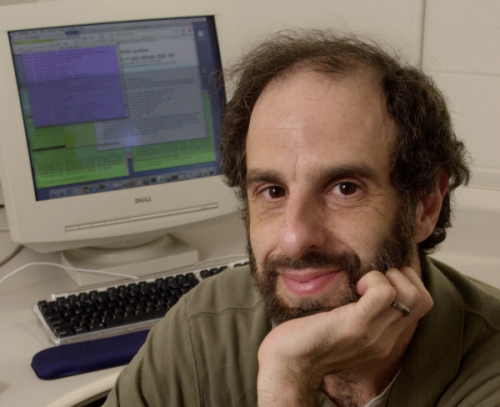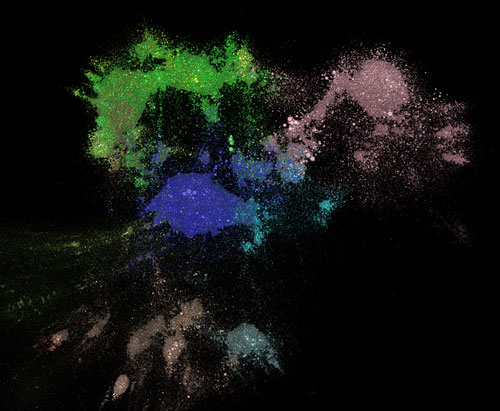Tag archives: arXiv
Robots at arXiv, physicist runs for US president, Einstein emojis galore

Preprint pioneer: Paul Ginsparg in 2002, long before arXiv received 10,000 papers per month. (Courtesy: MacArthur Foundation)
By Hamish Johnston
Last month the arXiv preprint server received more than 10,000 papers – the first time in the history of the physics paper depository. While arXiv papers are not peer reviewed, they are checked to ensure that they are “of interest, relevance and value” to the scientific community – which arXiv promises to do within 24 h of submission. So how do they do it? Surely someone doesn’t read every word of every paper? The answer can be found in “What counts as science?”, which appears in Nautilus. arXiv was set up in 1991 by the physicist Paul Ginsparg, who explains how the service uses machine learning to sort the wheat from the chaff – something that has attracted controversy.
View all posts by this author | View this author's profile
Milestone for preprint server
By Michael Banks
The arXiv preprint server received its millionth paper on 25 December 2014 – a major milestone for the repository, which was set up by the physicist Paul Ginsparg in 1991.
Cornell University’s arXiv has its roots in xxx.lanl.gov – a server set up by Ginsparg, who at the time was at the Los Alamos National Laboratory to share preprints in high-energy physics. It was originally intended for about 100 submissions per year, but rapidly grew in users and scope, receiving 400 submissions in its first half year.
View all posts by this author | View this author's profile
Welcome to the arXiv galaxy

Visualizing the interactive arXiv landscape. (Courtesy: Damien George, Rob Knegjens)
By Matthew Chalmers
With almost a million articles accrued over the past two decades, the arXiv preprint server has become an indispensable tool for physicists.
Now, thanks to a website called Paperscape developed by theoretical physicists Damien George at the University of Cambridge in the UK and Rob Knegjens at Nikhef in the Netherlands, its vast content can be visualized in all its glory.
The interactive graphic is based on a nifty algorithm that groups arXiv papers that cite each other together, as if they were linked by invisible springs, but forces those that don’t to repel each other. The resulting map resembles an irregularly shaped galaxy in which each “star” is a scientific paper, revealing how the various categories of research (shown in different colours) relate to each other.
What’s new with the ILC?
By Tushna Commissariat
Are you suffering from particle-collider withdrawal symptoms now that the LHC has begun its long shutdown? If so, you will be pleased to learn that you can focus your attention elsewhere.
The International Linear Collider Collaboration has posted an updated version of its 2013 Technical Design Report on the arXiv preprint server. It’s a short and sweet overview of the collider’s design, including “detailed descriptions of the accelerator baseline design for a 500 GeV e+e llinear collider, the R&D program that has demonstrated its feasibility, the physics goals and expected sensitivities, and the description of the ILD and SiD detectors and their capabilities”.
View all posts by this author | View this author's profile
Of mice and ‘little green men’
By Tushna Commissariat

Just called to say hello?
(Wikimedia Commons/Crobard)
There’s nothing quite like mentioning extraterrestrials or aliens to get us “Earthlings” all excited or riled up! Late last week, a paper popped up on arXiv, by astronomer Alan Penny from the University of St Andrews. He outlines an incident where, for a short while, the possibility of alien contact was seriously considered. He was talking about what was ultimately the discovery of the first pulsar; but at the time the researchers couldn’t help but wonder if they had come across the first “artificial signal” from outer space.
The exciting happenings began in August 1967, when Jocelyn Bell Burnell (then a graduate student working with Antony Hewish – controversially, only Hewish won the Nobel prize for the pulsar discovery in 1974) at the University of Cambridge, noticed a particular source that had a “flickering pattern” that, over a few weeks, she realized showed up regularly each day at the same sidereal time. That December Bell pinpointed the specific position of the source in the sky using another telescope and the discovery was confirmed. In the coming months, three more similar patterns were found and the researchers agreed on “pulsating stars” or pulsars being the source. But during those winter months, the possibility that they had encountered the first alien signal loomed large. In fact, Brunell and colleagues dubbed the first pulsar LGM-1 or “Little Green Men”; although it was changed to CP 1919, and is now known as PSR B1919+21.
View all posts by this author | View this author's profile
arXiv celebrates its 20th birthday

By Tushna Commissariat
Yesterday, on 14 August, the arXiv preprint electronic server celebrated its 20th birthday. In 1991 physicist Paul Ginsparg (right), who had then just moved to the Los Alamos National Laboratory in New Mexico, set up the online physics archive, initially know as the Los Alamos Preprint Server (xxx.lanl.gov), as a place where high-energy physicists could share preprints of their upcoming work. The initial idea, according to Ginsparg’s recent comment piece in Nature, was for 100 full-text articles or so to be submitted every year, each of which would be stored for three months. “By popular demand, nothing was ever deleted” writes Ginsparg.
The server received close to 400 subscriptions in the first six months alone. By 1999 when xxx.lanl.gov had changed its name to arXiv, the repository was collecting almost two thousand new articles every month. In 2001, when the server turned 10, Ginsparg moved to Cornell University in Ithaca, New York and took the server with him. By 2008 the world’s favourite e-print server officially had half a million papers published on it.
In 2008, when Physics World celebrated its 20th anniversary, Ginsparg recounted the early days of the Web and looked at how it has changed scientific communication. You can read his thoughts on the subject here.
Over the years, the arXiv server has had a huge impact on physics and paved the way to open-access publishing for scholarly journals. Many scientific journals now publish their content with unrestricted online access, and this has allowed scientific information to become freely accessible to researchers and the public.
Now, the server contains “about 700,000 full texts, receives 75,000 new texts each year, and serves roughly 1 million full-text downloads to about 400,000 distinct users every week. It has broadened, first to cover most active research fields of physics, then to mathematics, nonlinear sciences, computer science, statistics and, more recently, to host parts of biology and finance infiltrated by physicists,” according to Ginsparg.
Early last year, librarians at Cornell University asked for extra external funding to support the server, as the running costs were “beyond a single institution’s resources”. Its budget – which covers personnel as well as operating expenses – was predicted to increase from $400,000 in 2010 to $500,000 in 2012. Ginsparg says that an international meeting of sponsor institutions will be hosted by the Cornell Library next month and will look into transforming the arXiv server into a more community-endorsed resource. “My hope is that the barrier to implementation of new ideas in this realm will remain low enough that, if all else fails, some young researcher elsewhere can launch another tiny ship on a fateful trip.”
View all posts by this author | View this author's profile
